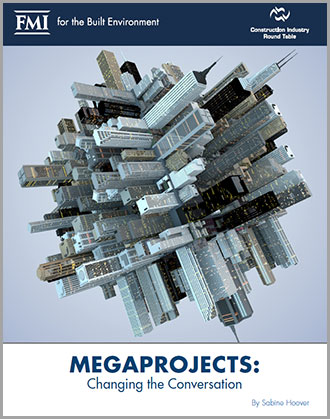Megaprojects: Changing the Conversation
How owners and project stakeholders are changing the way they work together to deliver successful megaprojects.

The widespread shortcomings and low success rate of megaprojects have been so pervasive that those involved have begun to question the very model. The recent exits of prominent engineering1 and construction (E&C) players in certain types of megaproject markets indicate the situation may be coming to a head.2 Yet, at the same time, megaprojects are constantly growing larger and increasing in number and complexity. Consider this: Between 2013 and 2018, the annual value of U.S. megaproject starts increased from 3% to approximately 33% of all U.S. construction project starts. Similarly, FMI predicts that over the next decade, annual construction put in place (CPiP) on megaprojects in the U.S. will increase nearly 600%, from about $50 billion to just over $350 billion (Exhibits 1 and 2).
These are big numbers. So what does this mean for the future of the E&C industry? Will we continue tormenting ourselves with project delays, cost overruns, lawsuits and political debacles until the end of time? Or has the industry finally reached a point where we can say “no more.”
The answers are unclear, but we are starting to see signs of a cultural shift in how owners, contractors and designers collaborate and interact with one another on megaprojects. Though success stories are anecdotal and limited, one of the key topics that keeps bubbling to the surface is trust. It is this basic emotional state, a central theme of all human relationships, that can make or break entire project teams and associated outcomes.
In this paper, we present FMI’s latest market forecast on megaprojects, share insights from industry leaders on five key ingredients that drive successful megaprojects, and offer questions and recommendations around how to change the name of the game.
1 In the context of this paper, “engineering” includes all design professionals. Also, in the context of our research, we use Flyvbjerg’s definition of megaprojects, which are large-scale, complex ventures that typically cost $1 billion or more and may take years to develop and build, involve multiple public and private stakeholders, are transformational and impact millions of people (Flyvbjerg, 2014).
2 Debra K. Rubin and Mary B. Powers. “After Bottom-Line Hits, More Firms Exit Fixed-Price Work.” ENR. August 7, 2019.
Exhibit 1. U.S. Megaprojects, Historical and Planned Activity Construction Starts/Awards, as Reported
Sources: FMI, building permits, ConstructConnect, Dodge
Exhibit 2. U.S. Megaprojects, Historical and Planned Activity
Construction Put in Place Forecast, 2012-2028
Sources: FMI, building permits, ConstructConnect, Dodge
About the Author
 Sabine Hoover is FMI’s content director and is responsible for leading content and research initiatives across the organization to drive thought leadership and promote industry engagement. She is also the chief editor for FMI’s flagship publication, the “FMI Quarterly.” She can be reached via email at [email protected].
Sabine Hoover is FMI’s content director and is responsible for leading content and research initiatives across the organization to drive thought leadership and promote industry engagement. She is also the chief editor for FMI’s flagship publication, the “FMI Quarterly.” She can be reached via email at [email protected].